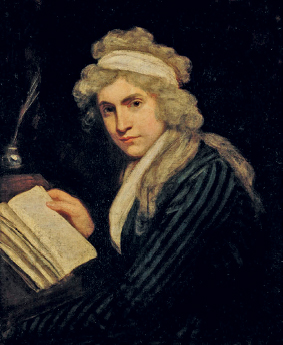Wollstonecraft’s groundbreaking work of literature – which advocated an equal education system for boys and girls and argued that women should be defined by their profession, not their husbands – established her as the mother of modern feminism.
Mary Wollstonecraft’s manifesto for feminism – a groundbreaking challenge to both men and women – is still essential reading for any student of equality.
Mary Wollstonecraft (1759–97) saw firsthand the influence of abusive, domineering or unfaithful husbands upon their wives and children. Her observations shaped her critical view of the place of women in society, which she felt women were partly to blame for accepting. Women, according to the prevailing view, did not have the intellectual capacity to be anything other than beautiful objects, educated only in the accomplishments that might adorn a man’s home – playing the piano and sewing, for example.
Wollstonecraft’s religious beliefs could not accept such a distinction. If men and women were equal in the sight of God, she reasoned, then surely they were capable of the same spiritual virtue. And in that case, they must be given the same opportunities. She was convinced that a decent quality of education for women was the solution. Her first book, Thoughts on the Education of Daughters (1787), introduced some of these ideas in an otherwise straightforward primer for young ladies. Five years later they were more fully developed and expressed in A Vindication of the Rights of Woman.
In her 1790 pamphlet A Vindication of the Rights of Men, Wollstonecraft contributed to the debate about the value of the French Revolution. She argued that tradition – for example, the right of kings to govern – was not fixed but open to challenge by just and reasonable argument. In The Rights of Woman she extended that argument.
Educated womanhood benefits everyone, Mary said. It was good for children, because it was a woman’s job to educate them; it was good for the family, because it made husband and wife equal and therefore a more stable couple; and it was good for the nation because it allowed women to make intelligent contributions to social and political debates. On the subject of domestic equality, she attacked promiscuous, unfaithful husbands and insisted that they too should take some responsibility for chastity and fidelity in a marriage. She called on men, who held the power, to take steps to liberate their wives, and criticised women for spending their time in shallow pursuits such as vanity and gossip.
It was a radical publication, but a successful one, which very quickly went to a second edition. For the most part, reviewers admired those ideas whose impact was already being felt in society and ignored the more extreme suggestions such as representation in Parliament and coeducation.
After her death her husband wrote a biography of her, Memoirs of the Author of A Vindication of the Rights of Woman, which revealed the unconventional life she had led – an illegitimate child, cohabitation, association with artists and radical thinkers. In doing so he unwittingly damaged her reputation; for a century Mary Wollstonecraft was more notorious for her lifestyle than her proto-feminism. But from the twentieth century onwards she has been reassessed and hailed as a pioneer of liberation by women everywhere.
Wollstonecraft’s groundbreaking work of literature – which advocated an equal education system for boys and girls and argued that women should be defined by their profession, not their husbands – established her as the mother of modern feminism.

John Opie’s circa 1791 portrait of Mary Wollstonecraft shows her distracted momentarily from her studies. It is an unusual portrait for its period, when only wealthy men were depicted as intellectuals.